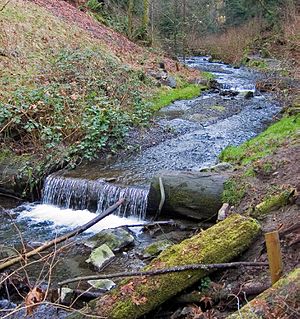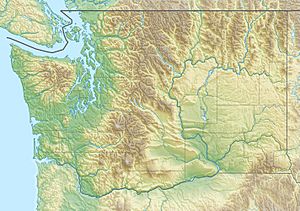Boeing Creek facts for kids
Quick facts for kids Boeing Creek |
|
|---|---|

Boeing Creek flowing over a man-made notched log, upstream from Hidden Lake
|
|
|
Location of the mouth of Boeing Creek in Washington
|
|
| Country | United States |
| State | Washington |
| County | King |
| Physical characteristics | |
| Main source | Shoreline Greenwood Ave and Carlyle Hall Rd, King County, Washington 380 ft (120 m) 47°45′2″N 122°21′27″W / 47.75056°N 122.35750°W |
| River mouth | Puget Sound KingCounty, Washington 0 ft (0 m) 47°44′57″N 122°22′56″W / 47.74917°N 122.38222°W |
| Length | 1.6 mi (2.6 km) |
| Basin features | |
| Basin size | 11.74 sq mi (30.4 km2) |
Boeing Creek is a small stream in the state of Washington, located in the city of Shoreline. This city is just north of Seattle. The creek is about 1.6 miles (2.6 km) long. It flows into Puget Sound, which is a large inlet of the Pacific Ocean.
The creek is named after William Boeing. He was the person who started the Boeing company. He built a large house (mansion) near the creek in 1913. Even though the creek has been changed a lot by people and pollution, it is still home to many native animals and fish.
Contents
What is the Path of Boeing Creek?
The journey of Boeing Creek starts from underground pipes. The main part of the creek comes out of storm drain pipes. This happens where Greenwood Avenue and Carlyle Hall Road meet. This spot is considered the creek's beginning.
The creek then flows through the Shoreline Community College campus. It also goes through Boeing Creek Park. This park is the northern part of Shoreview Park. At the western end of the park, the creek flows into a place called Hidden Lake.
Boeing Creek leaves Hidden Lake through a pipe under Innis Arden Way. It then flows west through a deep valley. It also goes under the BNSF train tracks. Finally, it empties into Puget Sound.
Does Boeing Creek Have Branches?
Yes, Boeing Creek has two main branches or "tributaries." A tributary is a smaller stream that flows into a larger one.
- The northern branch comes out of a pipe in Boeing Creek Park. Its water comes from drainage pipes under 6th Avenue. This branch joins the main creek in Boeing Creek Park.
- Another branch starts in the neighborhoods of Shoreview Hills and The Highlands. It flows north to join Boeing Creek below Hidden Lake.
The lowest part of Boeing Creek flows between two neighborhoods: The Highlands and Innis Arden. The Highlands is a private, gated community. This part of the creek cannot be accessed by the public.
How Much Water Flows in Boeing Creek?
During the 1990s, King County used special tools called stream gages to measure the water flow in Boeing Creek. One gage, called "Boeing Creek off Beach DR," was located close to where the creek meets Puget Sound.
This gage measured the water flow from 1991 to 1993. The most water measured in one day was about 16.86 cu ft/s (0.477 m3/s). The least amount of water was about 1.06 cu ft/s (0.030 m3/s). On average, about 2.7 cu ft/s (0.076 m3/s) of water flowed through the creek each day.
What is the Boeing Creek Watershed?
A watershed is an area of land where all the water drains into a single river or stream. Boeing Creek's watershed is about 11.74 square miles (30.4 km2) in size. It also includes about 3.4 miles (5.5 km) of the Puget Sound shoreline.
Most of this watershed is within the city of Shoreline. It reaches almost to the border of Snohomish County in the north. A small part of it extends into the city of Seattle in the south.
What is the History of Boeing Creek?
In 1913, William Boeing, the founder of the Boeing company, built a large house in The Highlands neighborhood. This house was located right along Boeing Creek. He lived there alone until 1921 when he got married and started a family. Over time, the creek became known as Boeing Creek.
Before this, the creek had other names like Hidden Creek and Hidden Lake Creek. The official name, Boeing Creek, was added to a national database in 1979.
William Boeing owned a lot of the land around the lower part of the creek. This land now includes Shoreview and Boeing Creek Parks. He used this land for hunting. He also built a small dam to create Hidden Lake, which he used for private fishing.
In the 1930s, Boeing divided about 400 acres (1.6 km2) of land north of the creek into smaller plots. He also had trees cut down (logged) on this land. He then sold the land to people who wanted to build houses. The Innis Arden neighborhood was built on this land after World War II.
The land that is now Boeing Creek Park was only partly logged. This left many tall, old trees, some over 200 feet (61 m) high. It is thought that the steep hillsides made it too expensive to cut down all the trees.
Boeing Creek Park and Shoreview Park
Much of the upper part of Boeing Creek, up to Hidden Lake, is inside Boeing Creek Park. This park is the northern part of Shoreview Park. Together, these parks cover about 88 acres (360,000 m2).
William Boeing gave the land that is now Shoreview Park to the Shoreline School District. In the mid-1970s, land south of Hidden Lake was cleared to build Shoreview High School. However, the school was never built because there wasn't enough money. This cleared land became overgrown with plants that are not native to the area.
In 1977, King County bought the land and created Shoreview Park. In 1997, the City of Shoreline took over ownership of both Shoreview Park and Boeing Creek Park.
There are trails in these parks that let people explore the middle part of Boeing Creek. Some trails are official and well-kept. There are also many "social trails" created by people walking. These often go up steep hills, which can cause the ground to wear away (erosion) and harm the creek.
What Animals Live in Boeing Creek?
Boeing Creek is home to several types of salmon and trout. These fish are very important to the local ecosystem.
- Chinook salmon (Oncorhynchus tshawytscha)
- Chum salmon (Oncorhynchus keta)
- Coho salmon (Oncorhynchus kisutch)
- Coastal cutthroat trout (Oncorhynchus clarki clarki)
A study in 1994 found young coho salmon in the lower part of Boeing Creek. This was below the Seattle Golf Course Dam. The same study found cutthroat trout in most of the creek.
Since 2000, a program called Salmon Watchers has observed fish in Boeing Creek. They often see coho and chum salmon. In 2003, they counted up to 160 chum salmon. In 2001, they saw 89 coho salmon. Two chinook salmon were also seen in 2000.
What Affects Fish in the Creek?
Fish populations are affected by several structures in the creek:
- M-1 Dam: This is a system that holds back stormwater on the main part of the creek.
- Retention-Detention Ponds: These are off-channel ponds in Boeing Creek Park that also manage stormwater.
- Hidden Lake and its dam: The lake itself and the dam that created it.
- Artificial waterfall: A 10-foot tall concrete waterfall downstream from Innis Arden Way.
- Seattle Country Club Golf Course Dam: A metal dam and pump station that provides water for the golf course.
None of these dams have fish passage ways. This means fish cannot swim past them. Because of this, fish that migrate from the ocean (like salmon) can only use the lower third of the creek.
What Plants Grow Along Boeing Creek?
The forest along Boeing Creek in Boeing Creek Park is a healthy native ecosystem. It is mostly free of plants that are not native and can harm the environment.
- There are many tall, old Douglas-fir and Western White Pine trees. Some are over 200 feet (61 m) tall. These trees were not cut down during logging.
- Salmonberry shrubs are common along the creek.
- Some areas have invasive species like Scotch broom, Himalayan blackberry, English ivy, and Herb Robert. These plants can take over and harm native plants.
- Native plants like Sword fern and Stinging nettle are also common.
How Has Boeing Creek Been Changed?
Boeing Creek has been changed by people over time.
- Early Changes: The land around the creek was logged. Hidden Lake was created, and the Seattle Country Club Golf Course Dam was built. Train tracks, now owned by BNSF, were built across the creek's mouth.
- Urban Development: In the 1960s, a shopping mall was built. This covered the creek's original starting point, which was a wetland. Because of this and other city growth, about 2 miles (3.2 km) of the upper creek now flows through pipes. Most of these pipes are on private land.
- Flooding and Erosion: After World War II, many buildings were put up in the creek's watershed. This changed how water flows into the creek, especially during rain. More water runoff causes more erosion (wearing away of the land) and sediment (dirt and small rocks) to be carried into the creek. This sediment has filled Hidden Lake several times.
- Restoring Hidden Lake: In the 1970s, heavy rains filled Hidden Lake with so much sediment that it became a meadow. In 1996, the lake was cleaned out (dredged) and restored. However, a big storm in 1997 caused more problems, filling the lake with sediment again. The lake was dredged and restored once more. The city of Shoreline now plans to dredge Hidden Lake when needed. They are also looking for long-term ways to control stormwater runoff, erosion, and sedimentation.
Controlling Stormwater and Wastewater
King County built a system in Boeing Creek Park to control stormwater.
- A large detention basin stores water during storms. This helps reduce the risk of flooding in the creek.
- An underground storage pipe was also built under the detention basin. This pipe is 12 feet (3.7 m) wide and about 640 feet (200 m) long. It can temporarily hold up to 500,000 gallons of wastewater during big storms. This helps keep wastewater from overflowing into Puget Sound. This pipe was finished in 2007.
- The Hidden Lake Pump Station was also replaced to handle more water. The old pump station used to overflow into Puget Sound about three times a year.
- The Boeing Creek Trunk Sewer pipe, which carries wastewater, was also replaced because it was old and too small. Sometimes, during heavy rains, wastewater would overflow from manholes into Puget Sound.
All these projects were part of a larger plan to improve the wastewater system. Construction started in 2006. The underground storage pipe was finished in 2007, the Boeing Creek Trunk in 2008, and the Hidden Lake Pump Station in 2009. The City of Shoreline is still planning more projects to manage stormwater. These projects aim to reduce flooding and improve the health of Boeing Creek.



